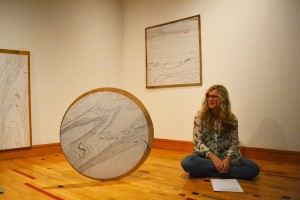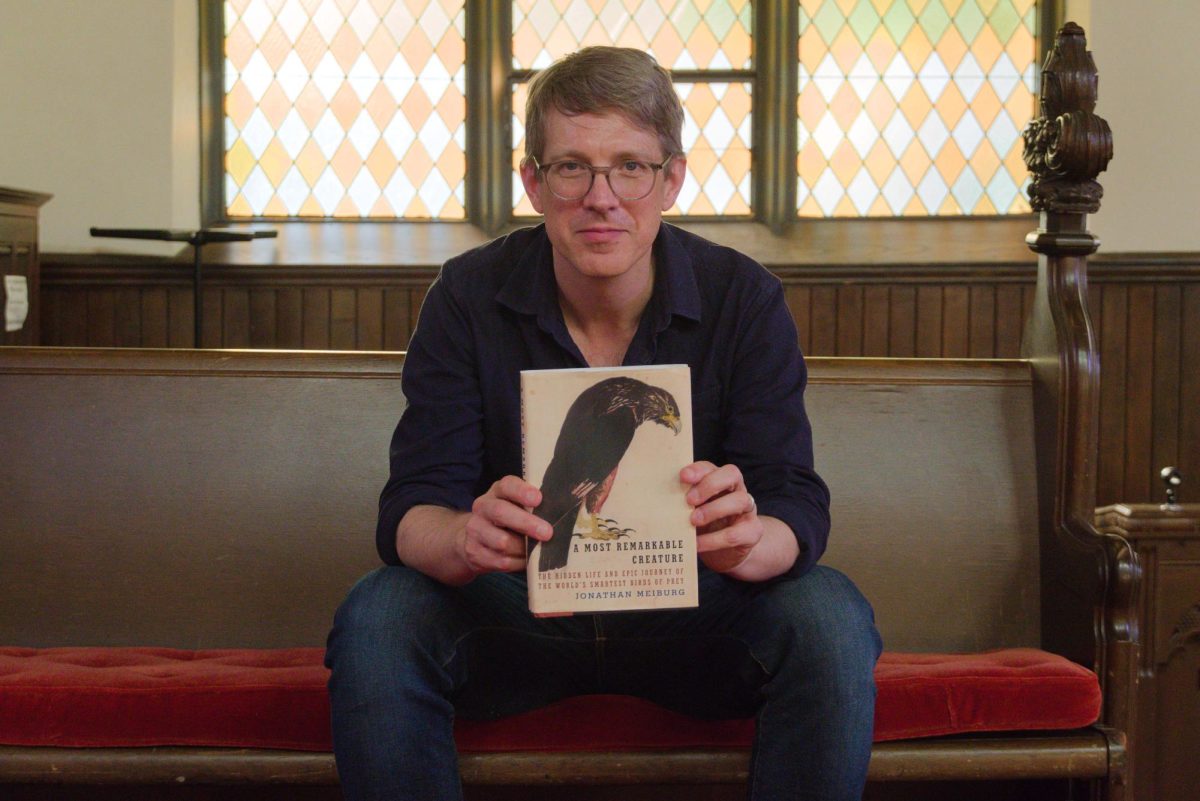By Christopher Squier
squierch@grinnell.edu
Discreetly filling the Smith Gallery with a slight buzzing and a number of serenely balanced circles of wood, Ninth Semester Art Fellow Lauren Flynn ’12 opened her delicate and introspective show Bridges and Byproducts last Tuesday.

Flynn’s pieces are unobtrusive, mediating the line between being installed in the space and naturally inhabiting it. They seem at home in the dim light and still atmosphere Flynn has given the often-noisy space. More a retreat than an exhibition, many of the pieces seem as if they’ve simply been lifted from her studio, in progress, unfinished but unconcerned with their completion.
Bridges and Byproducts creates a quiet atmosphere in Smith. Two video projections—rectangles of bright white with slight variations in light intensity—focus on one of the walls, but give nothing away. They float in a space of doubt, portraying something difficult to pin down.
Flynn’s wall text fleshes out the understated subject matter, although it becomes evident with time as well. The films archive the passage of light across a wall, showing the flashing of cars and storefronts projected through her apartment windows.
“I was lying on my apartment floor and I saw this beautiful shifting parallelogram of light go over the ceiling,” Flynn said. “I couldn’t move because I had to wait for [a plaster cast] to harden, and it was like Plato’s “[Allegory of the] Cave. I was watching everything that happened on the street happen on my ceiling. It was this reflection…and it was really beautiful. I started filming them whenever I saw that the light was really nice.”
Flynn’s other pieces continue in the vein of archiving and reflection. Two circular cuts of wood stand mid-spin, balanced on their edges, in the right corner of the gallery. In addition, two wooden squares balance against or hang on the wall, while a crosspiece of a tree is propped at the edge of the grouping.
Each piece of wood has been painted, often in white, and then carved back into to expose the wood’s original grain. In an attentive contemplation of the wood’s grain, Flynn draws our attention to the often unobserved and ignored, emphasizing the natural elegance of the wood.
“I was making prints on silk of the lines, and one day I inked that one up white and I couldn’t print it,” Flynn said. “It shocked me, it was really beautiful and I really like it. I just kept it inked.”
In Flynn’s statement, she notes that her practice “center[s] on noticing and carefully recording subtle, often overlooked aspects of reality as a means towards inner contemplation.”
The focus on the meditative gaze, the calming process of looking and recording, carries throughout the exhibition and translates, as well, to the act of viewing the show. The understated lines and forms of Flynn’s art give the viewer the same impression of introspection.
On the far wall, Flynn is adding daily to Bridges and Byproducts, carving away at the wall to expose its natural irregularities. It comes across as the opposite of whitewashing, exposing the imperfections and natural variation on the frequently repainted walls and drawing attention to the many layers and various textures present in the wall.
This process is the most interesting of all the pieces in Bridges and Byproducts, as it is an evolving piece of work that combines all of Flynn’s concerns for a meditative and attentive process with the adaptation of drawing to a variety of media in a site-specific manner.
At the moment, the carvings spiral across the wall like an aerial map of rivers and tributaries. The faint, gray lines are not immediately noticeable, but become more compelling upon entering the space of the gallery.
Highlighting what is usually just negative whiteness, this delicate adjustment of the gallery wall draws attention to the non-space of the gallery and therefore to all the commonly overlooked aspects of the space.
Of course, a show this minimal presents an immediate problem in the sense that many aspects of the gallery are better overlooked. The rigging of the projector cords trailing across the ceiling and up into the socks of unused lights stands out much more clearly, as do the tracks for the lights, the electrical sockets—although Flynn has gone to the trouble to use white switch plates—and the abrasively vibrant floor.
Nevertheless, these are minor concerns, and Flynn’s show seems removed from them, succeeding in relating its quiet reflection on our surroundings without undue concern for the somewhat awkward logistics of the gallery.























































